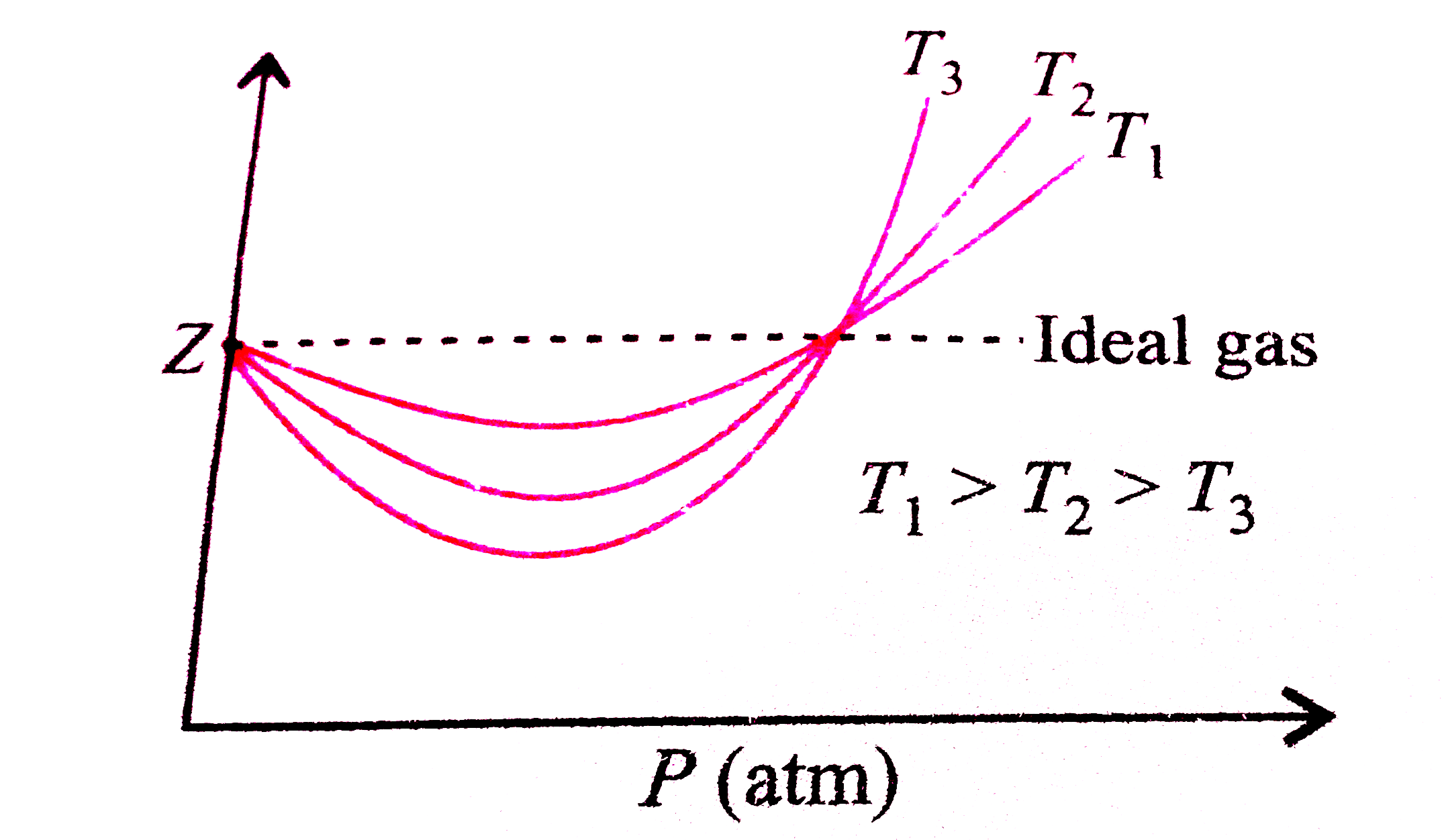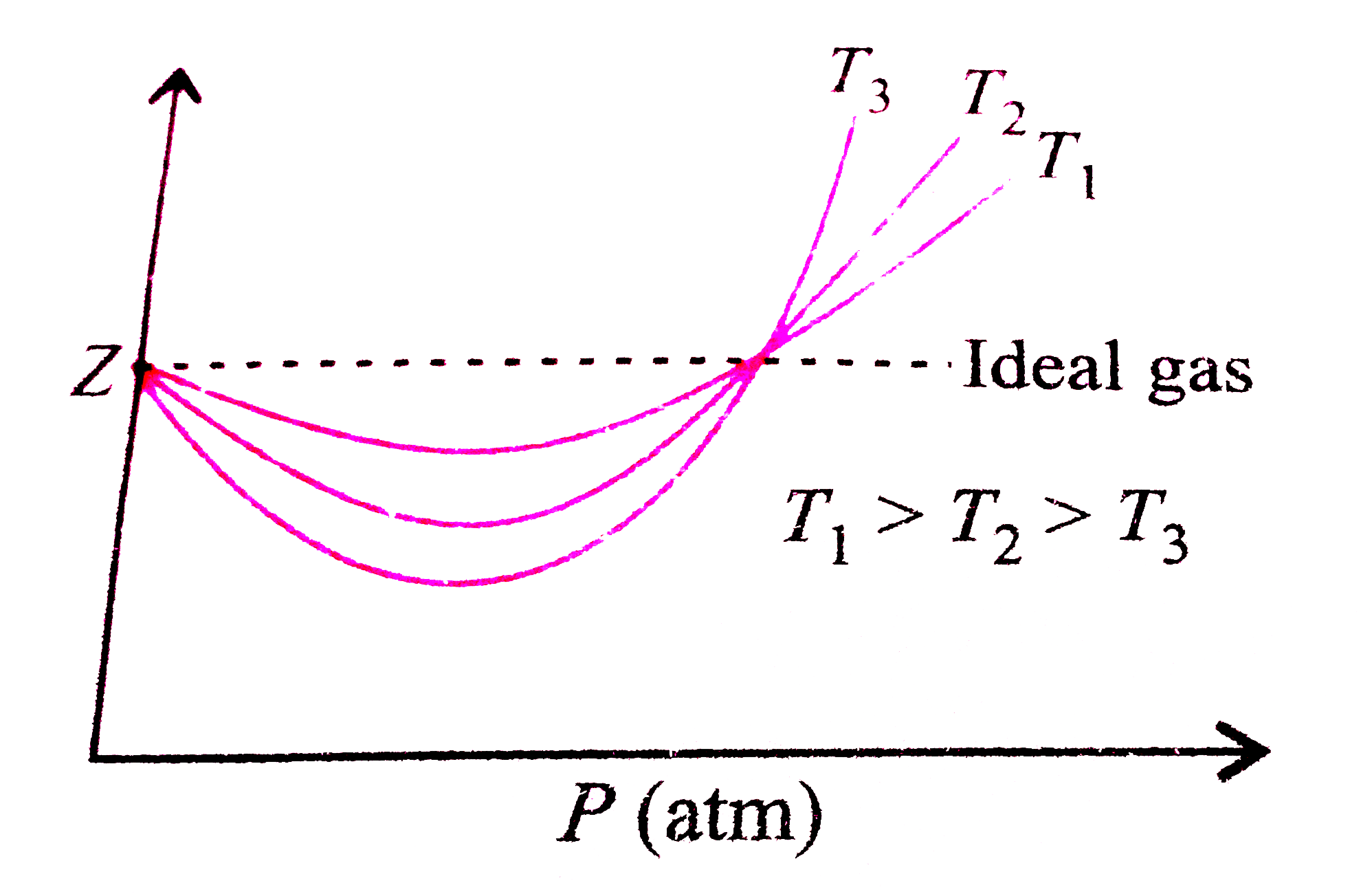At Boyle's temperature the value of compressibility factro Z=(PVm(/RT=Vreal/Val) has a value of 1 over a wide range of pressure. This is due to the fact that in the van der Waal's equation
The constant ‘a’ is negligible and not ‘b’
The constant ‘b’ is negligible and not ‘a’
Both the constant ‘a’ and ‘b’ are negligible
The effect produced due to the molecular attraction compensates the effect produced due to the molecular volume
The correct Answer is:D
To solve the question regarding Boyle's temperature and the compressibility factor Z in the context of the van der Waals equation, we can follow these steps:
1. Understanding the Compressibility Factor:
The compressibility factor Z is defined as:
Z=PVmRT
where P is the pressure, Vm is the molar volume, R is the universal gas constant, and T is the temperature.
2. Definition of Boyle's Temperature:
Boyle's temperature is defined as the temperature at which a real gas behaves like an ideal gas over a range of pressures. At this temperature, the compressibility factor Z approaches 1.
3. Van der Waals Equation:
The van der Waals equation for real gases is given by:
(P+an2V2)(V−nb)=nRT
where a and b are the van der Waals constants that account for intermolecular forces and the volume occupied by gas molecules, respectively.
4. Behavior at Boyle's Temperature:
At Boyle's temperature, the effects of the van der Waals constants a and b become negligible. This means that the intermolecular forces and the volume occupied by the gas molecules do not significantly affect the behavior of the gas.
5. Reduction to Ideal Gas Law:
When a and b are negligible, the van der Waals equation simplifies to:
PV=nRT
This is the ideal gas equation, which implies that:
Z=PVRT=1
6. Conclusion:
Therefore, at Boyle's temperature, the compressibility factor Z equals 1 because the van der Waals constants a and b are negligible, allowing the gas to behave ideally.
Final Answer:
At Boyle's temperature, the value of compressibility factor Z=1 over a wide range of pressure due to the fact that in the van der Waals equation, the constants a and b become negligible, leading the equation to approximate the ideal gas law.
The compressibility factor Z is defined as:
Z=PVmRT
where P is the pressure, Vm is the molar volume, R is the universal gas constant, and T is the temperature.
Boyle's temperature is defined as the temperature at which a real gas behaves like an ideal gas over a range of pressures. At this temperature, the compressibility factor Z approaches 1.
The van der Waals equation for real gases is given by:
(P+an2V2)(V−nb)=nRT
where a and b are the van der Waals constants that account for intermolecular forces and the volume occupied by gas molecules, respectively.
At Boyle's temperature, the effects of the van der Waals constants a and b become negligible. This means that the intermolecular forces and the volume occupied by the gas molecules do not significantly affect the behavior of the gas.
When a and b are negligible, the van der Waals equation simplifies to:
PV=nRT
This is the ideal gas equation, which implies that:
Z=PVRT=1
Therefore, at Boyle's temperature, the compressibility factor Z equals 1 because the van der Waals constants a and b are negligible, allowing the gas to behave ideally.
At Boyle's temperature, the value of compressibility factor Z=1 over a wide range of pressure due to the fact that in the van der Waals equation, the constants a and b become negligible, leading the equation to approximate the ideal gas law.
Topper's Solved these Questions
- BOOK - VMC MODULES ENGLISHCHAPTER - STATES OF MATTEREXERCISE - Level-2 (NUMBERICAL VALUE TYPE FOR JEE MAIN15videos
STATES OF MATTER
- BOOK - VMC MODULES ENGLISHCHAPTER - STATES OF MATTEREXERCISE - JEE-Main ( ARCHIVE )17videos
STATES OF MATTER
- BOOK - VMC MODULES ENGLISHCHAPTER - STATES OF MATTEREXERCISE - Level-175videos
STATES OF MATTER
- BOOK - VMC MODULES ENGLISHCHAPTER - STATES OF MATTEREXERCISE - IMPECCABLE50videos
STATES OF MATTER
- BOOK - VMC MODULES ENGLISHCHAPTER - STOICHIOMETRY - IEXERCISE - JEE Advanced (Archive)31videos
STOICHIOMETRY - I
Similar Questions
Knowledge Check
- Question 1 - Select One
For a real gas , the compressibility factor Z has different values at different temperatures and pressures . Which of the following is not correct under the given conditions ?
AZ < 1 at very low pressure .BZ > 1 at high pressure .CZ = 1 under all conditions .DZ = 1 at intermediate pressure
Compressibility factor, Z of a gas is given as Z=pVnRT
(i) What is the value of Z for an ideal gas ?
(ii) For real gas what will be the effect on value of Z above boyle's temperature ?View SolutionOne of the important approach to the study of real gases involves the analysis of parameter Z called the compressibility factor Z=PVmRT where P is pressure, Vm is molar volume, T is absolute temperature and R is the universal gas constant. such a relation can also be expressed as Z=(VmrealVmal) (where Vmal and Vmreal are the molar volume for ideal and real gas respectively). Gas corresponding Z<1 have attractive forces amoung constituent particles. As the pressure is lowered or temperature is increased the value of Z approaches 1. (reaching the ideal behaviour)
For a real gas GZ>1 at STP Then for 'G': Which of the following is true:View SolutionOne of the important approach to the study of real gases involves the analysis of parameter Z called the compressibility factor Z=PVmRT where P is pressure, Vm is molar volume, T is absolute temperature and R is the universal gas constant. such a relation can also be expressed as Z=(VmrealVmal) (where Vmal and Vmreal are the molar volume for ideal and real gas respectively). Gas corresponding Z<1 have attractive forces amoung constituent particles. As the pressure is lowered or temperature is increased the value of Z approaches 1. (reaching the ideal behaviour)
ObservationConclusionI.Z=1I.The gas need not be showing the ideal behaviourII.Z>1II.On applying pressure the gas will respond byincreasing its volumeIII.Z<1III.The gas may be liquefiedIV.Z→1for lowPIV.The gas is approaching the ideal behaviourView SolutionThe internal pressure loss of 1mol of van der Waals gas over an ideal gas is equal to
View SolutionBoyle's temperature or Boyle point is the temperature at which a real gas starts behaving like an ideal gas over a particular range of pressure. A graph is plotted between compressibility factor Z and pressure P.

What is the deviation of real gas from ideal behaviour in terms of compressibility factor , Z ?View SolutionBoyle's temperature or Boyle point is the temperature at which a real gas starts behaving like an ideal gas over a particular range of pressure. A graph is plotted between compressibility factor Z and pressure P.

What is the variation of Z with pressure ?View SolutionBoyle's temperature (TB) : It is the temperature at which a real gas exhibits ideal behavior in low pressure range. Different gases have different value of TB, which is related to the van der Wall's constant a and ab as follows: TB=aRb
The compressiblity factor for a real gas is given as Z=1+0.35P−168TP. Where P is in bar and T is in Kelvin. What is the Boyle's temperature of the gas?View Solution

